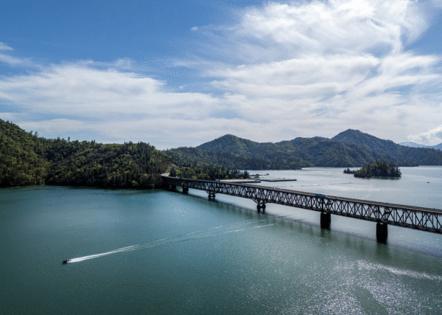State officials say federal cuts threaten California's environment
Published in News & Features
LOS ANGELES — Budget cuts, staff reductions and other sweeping changes from the federal government are posing real threats to California’s environment and progress against climate change, state officials said Thursday.
At a gathering of the state’s top leaders in wildfire response, water resources, natural lands and clean energy, they underscored the ways the Golden State has long worked together with federal agencies — and how actions by the Trump administration are putting that cooperative work in jeopardy.
“We want federal agencies to succeed, and in fact we need them to succeed,” said Wade Crowfoot, California’s natural resources secretary, noting that 48% of the state’s land is owned and managed by the federal government. “Because if they fail, it impacts the prosperity and safety of Californians.”
State agencies such as the Wildfire and Forest Resilience Task Force, the Department of Water Resources and the Energy Commission are among those struggling to keep up with the rapid pace of federal cutbacks, officials said. The Trump administration has said its changes are geared toward reducing federal waste, saving taxpayers money and increasing American energy independence.
Yet state officials are increasingly worried about shifting national priorities, including a 10% staffing cut at the U.S. Forest Service— the largest federal firefighting entity that often works hand in hand with the California Department of Forestry and Fire Protection to manage forests and combat blazes. Many of the Forest Service’s eliminated employees were in support roles, such as logistics and transportation, that are crucial to ensuring firefighters can do their job, according to Patrick Wright, director of the California Wildfire and Forest Resilience Task Force.
“All that knowledge is going to be lost that is so critical when we’re both fighting fires and trying to prevent fires, so the whole system is going to suffer,” he said.
Wright noted that the president’s proposed 2026 budget would also eliminate many of the Forest Service’s top scientists, which he said would negatively affect data systems, analyses and other crucial tools. And although California has made progress in its efforts to improve forest health and reduce wildfire risk through forest thinning, prescribed burns and fuel breaks, Wright said he is concerned about the impacts of the president’s order to open up millions of acres of national forestland for timber production, including all 18 of California’s national forests.
“Not that timber isn’t important, but we can’t keep our eye off of the need for fire and forest resilience in California,” he said. There is “serious concern by Forest Service people on the ground that if we solely focus on timber, we’re going to lose our focus on protecting communities, preventing wildfire, protecting habitat and other key measures of success.”
It’s not only wildfires that officials are worried about, however. Karla Nemeth, director of the California Department of Water Resources, said the agency is reeling from several changes to key components of its water supply system.
Among them are staff reductions at the federal U.S. Bureau of Reclamation, which oversees the Central Valley Project — a vast network of dams, reservoirs and canals that delivers water supplies across the state. The Central Valley Project is the federal companion to the State Water Project, which performs a similar function.
This year, the Bureau of Reclamation has lost about 1,400 staff members— or more than a quarter of its workforce — and is facing a potential budget cut of 33%, Nemeth said.
“Because a lot of our infrastructure is operated in a cooperative way, it does have an expanded effect on how our whole system is put together,” Nemeth said.
The state also works closely with the Bureau of Reclamation to manage flood protection in California, where several levee and dam safety projects are now in jeopardy, Nemeth said. They include projects to enhance the system along the American River in Sacramento — one of the most flood-prone urban areas in the U.S. — and to address the devastating 2023 levee breach that flooded the community of Pajaro.
Other state leaders, including Armando Quintero, director of California State Parks, shared similar fears. He said the National Park Service is facing a potential $1-billion budget cut and has lost 24% of permanent staff since January. More than 100 superintendent positions are vacant. It’s resulted in canceled tours, closed campgrounds, reduced hours and other effects in California’s nine national parks.
Meanwhile, all 18 of California’s national forests are losing staff, and its regional office is likely to be eliminated, he said. The state’s roadless areas and national monuments are similarly facing the threat of lost protections and closures.
Jenn Eckerle, deputy secretary for oceans and coastal policy at the California Natural Resources Agency, said the state is facing the loss of funding for coastal protection, including about $870 million previously awarded by the Federal Emergency Management Agency‘s Building Resilience Infrastructure and Communities grant program, which has been canceled.
One such project was an $18-million BRIC grant to help the city of Imperial Beach protect infrastructure, habitat and coastal access from sea level rise through a nature-based levee, Eckerle said.
“Obviously these actions are going to hamper California’s ability to predict, respond and adapt to climate impacts like sea level rise, ocean acidification, marine heat waves, and will lead to impacts for our coastal economies and ecosystems,” she said.
Perhaps one of the biggest areas to suffer is California’s ambitious push for clean energy. The state has committed to achieving carbon neutrality by 2045 throughout its economy and has been a nationwide leader in the move toward solar and wind power and electric vehicles.
Robert Chun, chief of staff to the chair of the California Energy Commission, said the Trump administration has made moves to end long-standing tax credits for clean energy. They will apply only to projects placed into service by December 2027, or that start construction by July 2026.
The administration is also canceling $3.7 billion in awards managed by the Department of Energy’s Office of Clean Energy Demonstrations — at least $800 million of which was supposed to go to California, Chun said. That office’s staff has been reduced from about 250 people to 35, he said.
He added that the Trump administration has removed basic energy efficiency regulations that have existed for decades, and has made it harder for California to reduce pollution by revoking waivers it is granted under the Clean Air Act to enforce tailpipe emission standards.
Chun said the result of these changes is likely to be worse air quality, higher energy costs, reduced grid reliability and limited growth for new industries such as artificial intelligence. However, he said he remains optimistic about the state and nation’s progress toward clean energy, which he sees as inevitable.
“They can slow the transition to clean energy here and there, but they can’t stop it,” Chun said. “We shouldn’t back down from our vision of a clean energy future, or lower our expectations for what we can achieve here in California.”
Indeed, state officials said there are ways to push back. California is party to several lawsuits against the Trump administration, including one challenging its attempt to overturn the state’s clean air waivers. The state is also working to hire laid-off federal employees, particularly those who were working on crucial projects.
Last month, conservation groups across the state and country also came together to push back against a GOP-led proposal to sell off millions of acres of public lands in Western states, which would have made about 10 million acres in California eligible for sale. Sen. Mike Lee, R-Utah, who spearheaded the effort, ultimately nixed the proposal.
“California remains committed and focused to our priorities and our values,” said Crowfoot, the state’s natural resources secretary. He encouraged residents to stay informed, voice their concerns to public officials and work to build broad-based bipartisan coalitions to amplify shared priorities when it comes to the state’s environment.
“What we’re talking about today,” he said, “are things that we all care about.”
©2025 Los Angeles Times. Visit at latimes.com. Distributed by Tribune Content Agency, LLC.







Comments